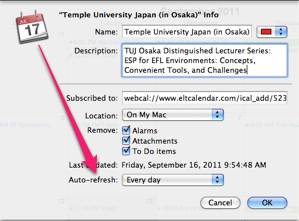ETJ Saitama:
�Sainokuni Joint JALT - ETJ Workshop
Date: Sunday, June 13th, 2010 Time: 1:00 PM - 4:50 PM
Speaker: Ivan Botev, Graham Finch, John Finucane, Sanae Kawamoto, Shaun Leyland, Calvin Ogata
Description:
This is the 2nd ETJ Saitama and JALT Omiya Sainokuni Workshop for Teachers of Japanese Young Learners.
CHAOS: A Communication Activity
This is the main communication activity for third grade junior high school students, in their first lesson of the English Communication Abilities Development Program (ECAD). It gives teachers a chance to determine students' abilities and to set the tone for the semester and the year. The chaos activity is a fun way for students to adjust to the kinds of activities they will be expected to do throughout the year. Students will have to perform different types of tasks, some of which they will need assistance understanding. By cooperating with each other, seeking help from the teacher(s), and completing the activity students will need to use all of the communicative skills available to them.
Sign Up
This presentation will demonstrate how I use sign language in my school through songs. We will also learn how to sign the alphabet, which I think can be an effective spelling and a memory aid. As there is not one universal sign language this has led me to slight dilemma. Should I use Japanese (JSL), American (ASL) or, because I am from England, British (BSL) sign language? If there is enough time, I would like to discuss what the merits and/or demerits of using sign language in an EFL classroom might be.
Using Adjectives as a Communication Strategy
This presentation is about two lessons that were created to prepare students for learning the new skills they would need in junior high school English classes. There were three aims for these lessons. 1) For students to use multiple adjectives, in a sentence, in the correct order. 2) For students to learn and use the word 'not' as a communication strategy. 3) To introduce Romanji as a part of the lesson.
Simple Sentences for Young Learners
The presenter will show you how to teach vocabulary and simple sentences in a communicative way to young learners. This method can be used in adult classes too, especially for low-level beginners. The presenter will show you a couple of games using easy sentences that can help students learn in a fun way.
Do Your Mistakes Stand Out?
Students often do not recognize they have spoken English in a way not usually used in general conversation. They are also often very afraid of making a mistake and feel uncomfortable when they realize they have made one. The opposite also exist with students who are not afraid of making a mistake but don 't improve because the number of mistakes does not decrease. Let us review how teachers can assist them in realizing that making a mistake is natural and will always happen but with care they may be reduced to a level that allows for general communication with others.
Using Music in the Classroom
Calvin is planning to talk about one of the well-known techniques he uses quite successfully in elementary schools. He will talk a little about the usefulness of songs and chants when teaching students, then demonstrate how he actually introduces a song to a class for the first time. Even if music is not one of your stronger skills, Calvin believes you will definitely want to incorporate this technique after the presentation. Some song and chant books will be suggested may beneficial to use when planning for your own classes.
Organization: ETJ Saitama (English Teachers in Japan) (ETJ Saitama)
Cost: 500 yen
Venue: Shogai Gakusho Soa Center, Center Plaza 5F, Sakuragicho Kominkan, 1-10-18 Sakuragicho, Omiya
Location: Saitama City, Saitama Prefecture, Japan
![]() Add this to iCal
Add this to iCal
![]() (Need help?)
(Need help?)
![]() Add to Outlook
Add to Outlook
![]() (Need help?)
(Need help?)
You can add this event to your iCal calendar.
- Click on the iCal icon. Your iCal software will start.
- Click 'Subscribe':

- Under 'Auto Refresh', select 'Every day' in case the the basic details change:

You can add this event to your Microsoft Outlook calendar.
- Click on the MS Outlook icon.
- See what happens.
- Tell us what happens. I don't have MS Outlook on a Windows computer, so I can't test it.
- If you click on the icon and nothing happens, do this:
- Right-click on the icon and save the file.
- According to Microsoft's support page, in Outlook's File menu, you should click Import and Export.
- Click to select Import an iCalendar or vCalendar file (*.vcs), and then click Next.
- Click to select the vCalendar file you've just saved, and then click Open.
Contact ETJ Saitama
Website: www.facebook.com/profile.php?id=100094211583787
Email QR Code:





